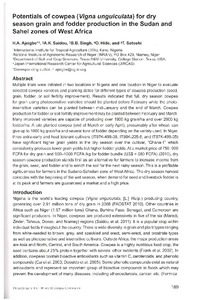| dc.contributor.author | Saidou, A.K. |
| dc.contributor.author | Ajeigbe, Hakeem A. |
| dc.contributor.author | Hide, O. |
| dc.contributor.author | Satoshi, T. |
| dc.contributor.author | Singh, B.B. |
| dc.date.accessioned | 2019-12-04T11:14:05Z |
| dc.date.available | 2019-12-04T11:14:05Z |
| dc.date.issued | 2011 |
| dc.identifier.citation | Saidou, A.K., Ajeigbe, H.A, Hide, O., Satoshi, T. & Singh, B.B. (2011). Potentials of cowpea (Vigna unguiculata) for dry season seed and fodder production in Sahelian sandy soil of Niger. American-Eurasian Journal of Agricultural & Environmental Sciences, 11(1), 71-78. |
| dc.identifier.issn | 1818-6769 |
| dc.identifier.uri | https://hdl.handle.net/20.500.12478/2641 |
| dc.description.abstract | Recent surge in dry cowpea seed price, grain and fodder demand in Niger Republic has resulted in the search for appropriate cultivars for dry season production for seed, grain, and fodder. However in addition to the common constraints to cowpea production in the wet season, high temperature in the months of March, April, and May is a major concern in cowpea production in the dry season in the Sahelian conditions of Niger. Preliminary trials have shown that it is possible to grow cowpea in the dry season if heat tolerant varieties can be found. Consequently, four cowpea cultivars (IT97K-499-38, lT98K-205-8, Ghana-l, and IT97K-499-35) selected from previous trials were evaluated for their dry season grain and fodder production potentials. Results revealed that the potential for dry season cowpea grain and fodder production is very high, with a grain harvest ranging between 200 and 2183 kg/ ha and an average of 1452 kg/ha, which is much higher than wet season production. At a current (2009) market price of 750-900 F CFA and 900 to 1000/kg (US$ = 480 F CFA) of dry grain and fodder bundle respectively, dry season cowpea production stands first as an alternative for farmers to increased income, grain, seeds, and fodder and enrich the soil for the next rainy season. This is a profitable agribusiness for farmers in the country and across the border. Farmers could get even higher returns by producing seeds which sells for over 1000 F CFA/kg during the dry season harvest, which also coincides with the beginning of the wet season and the peak demand for seeds and fodder. |
| dc.description.sponsorship | Japan International Research Center for Agricultural Sciences |
| dc.format.extent | 71-78 |
| dc.language.iso | en |
| dc.subject | Dry Season Seed Multiplication |
| dc.subject | Improved Varieties Of Cowpea |
| dc.subject | Vigna Unguiculata |
| dc.subject | Grain |
| dc.subject | Fodder |
| dc.title | Potentials of cowpea (Vigna unguiculata) for dry season seed and fodder production in Sahelian sandy soil of Niger |
| dc.type | Journal Article |
| dc.description.version | Peer Review |
| cg.contributor.affiliation | National Institute of Agronomic Research of Niger |
| cg.contributor.affiliation | International Institute of Tropical Agriculture |
| cg.contributor.affiliation | Japan International Research Center for Agricultural Sciences |
| cg.contributor.affiliation | Texas A&M University |
| cg.coverage.region | Africa |
| cg.coverage.region | West Africa |
| cg.coverage.country | Nigeria |
| cg.coverage.country | Ghana |
| cg.authorship.types | CGIAR and developing country institute |
| cg.iitasubject | Cowpea |
| cg.iitasubject | Plant Breeding |
| cg.iitasubject | Weeds |
| cg.iitasubject | Meteorology And Climatology |
| cg.journal | American-Eurasian Journal of Agricultural & Environmental Sciences |
| cg.howpublished | Formally Published |
| cg.accessibilitystatus | Limited Access |
| local.dspaceid | 93446 |
| cg.targetaudience | Scientists |


